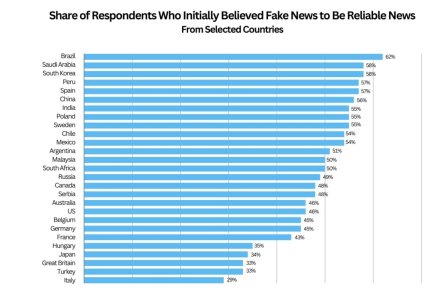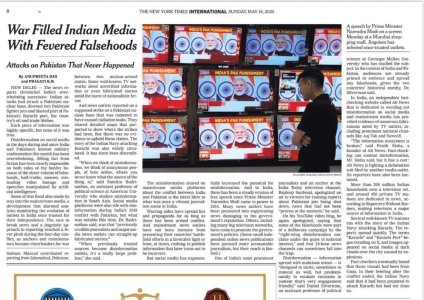emranabbas
ODI Debutant
- Joined
- Oct 29, 2013
- Runs
- 11,284
Follow along with the video below to see how to install our site as a web app on your home screen.
Note: This feature may not be available in some browsers.

 theprint.in
theprint.in


No wonder there's lot of delusional indians running around on this forum based news outlets ranked number 1 for fake newsYup.
Not surprised at all.

This is a 'saazish' by Pakistan.No wonder there's lot of delusional indians running around on this forum based news outlets ranked number 1 for fake news


Bangladesh is also tagged in red along with India. Is this a case of author don't know Bangladesh is a separate country or it is also as infamous in fake news as India?Yup.
Not surprised at all.
No need to act holier than thou. Pakistan is in dark Amber zone which means between 4th - 6th.This is a 'saazish' by Pakistan.
Instead of feeling jealous of lower-ranked Pakistan and Bangladesh, let's come together and celebrate our victory.Bangladesh is also tagged in red along with India. Is this a case of author don't know Bangladesh is a separate country or it is also as infamous in fake news as India?
No need to act holier than thou. Pakistan is in dark Amber zone which means between 4th - 6th.
Considering Pakistan has a significantly lower population than India, it is alarming they are either 4th, 5th or 6th in the list of most fake stories.
It is more of a case of OP being pot calling kettle black.



No one is jealous...I am just correcting it.Instead of feeling jealous of lower-ranked Pakistan and Bangladesh, let's come together and celebrate our victory.
View attachment 154811


LOl... you are crazy bruh.... Are you saying that WORLD ECONOMIC FORUM REPORT IS FROM PAKISTAN???
We should be merging this thread with the existing one @BouncerGuy
Fake news is a worldwide problem.
If there's one thing we all agree regardless of our political, religious and policy views...it's that we need to fight FAKE news at every point.
Doesn't matter if it comes from right wing sources or left wing sources.
Wrong is wrong.
Fake news elicits emotions.
It engineers perception.
It causes IMMENSE harm (even if it's debunked later).
The only way to fight fake news is to maintain constant vigil.
So let's compile all the fake news in India under one thread so that it's easy for us to get upto speed on what's real and what's fake.
- sensible-indian-fan
- Replies: 112
- Forum: Time Pass and Sports
If this thread was opened by me, it would have been merged or binned in a heartbeat

Where does Pakistan rank?LOl... you are crazy bruh.... Are you saying that WORLD ECONOMIC FORUM REPORT IS FROM PAKISTAN???
crazy delusions here...LOL
merging won't change the fact that India is number 1... LOL
Source here https://www.statista.com/chart/31605/rank-of-misinformation-disinformation-among-selected-countries/
One thing is confirmed, not on number 1... LIKE INDIA.Where does Pakistan rank?
Congratulations, you have successfully forced the mods to merge yet another thread just because its headline hurt your eyes.We should be merging this thread with the existing one @BouncerGuy
Fake news is a worldwide problem.
If there's one thing we all agree regardless of our political, religious and policy views...it's that we need to fight FAKE news at every point.
Doesn't matter if it comes from right wing sources or left wing sources.
Wrong is wrong.
Fake news elicits emotions.
It engineers perception.
It causes IMMENSE harm (even if it's debunked later).
The only way to fight fake news is to maintain constant vigil.
So let's compile all the fake news in India under one thread so that it's easy for us to get upto speed on what's real and what's fake.
- sensible-indian-fan
- Replies: 112
- Forum: Time Pass and Sports
If this thread was opened by me, it would have been merged or binned in a heartbeat



Can we update the thread title to India is ranked number #1 in fake news since its now officialWe should be merging this thread with the existing one @BouncerGuy
Fake news is a worldwide problem.
If there's one thing we all agree regardless of our political, religious and policy views...it's that we need to fight FAKE news at every point.
Doesn't matter if it comes from right wing sources or left wing sources.
Wrong is wrong.
Fake news elicits emotions.
It engineers perception.
It causes IMMENSE harm (even if it's debunked later).
The only way to fight fake news is to maintain constant vigil.
So let's compile all the fake news in India under one thread so that it's easy for us to get upto speed on what's real and what's fake.
- sensible-indian-fan
- Replies: 112
- Forum: Time Pass and Sports
If this thread was opened by me, it would have been merged or binned in a heartbeat

LOl... you are crazy bruh.... Are you saying that WORLD ECONOMIC FORUM REPORT IS FROM PAKISTAN???
crazy delusions here...LOL
merging won't change the fact that India is number 1... LOL
Source here https://www.statista.com/chart/31605/rank-of-misinformation-disinformation-among-selected-countries/
Fake News propaganda factory or False flag factory is Pakistan.
Even Pakistan DGISPR used a doctored videos of Indian army PC .
Pakistan Navy spokesperson used a 3 year old picture in recent MEDIA PC
Pakistan most SR journalist Hamid Mir used a dozens old videos of Indian jets to count in recent battlefield or he even used a rajasthan fire factory video to show udhampur base fake news
Theses are Just small examples .


Think the title is fine as it is a compilation thread. Infact, I think we need to have a Fake News Compilation thread for Pakistan considering it is a Pakistani forum.Can we update the thread title to India is ranked number #1 in fake news since its now official
@The Bald Eagle @BouncerGuy

Aisa mat karo, @Rajdeep ko julaab lag jayenge.Can we update the thread title to India is ranked number #1 in fake news since its now official
@The Bald Eagle @BouncerGuy


Think the title is fine as it is a compilation thread. Infact, I think we need to have a Fake News Compilation thread for Pakistan considering it is a Pakistani forum.
#HaiHimmat?



 redline.digital
redline.digital
Last survery was conducted in 2024 for the year 2023 so currently as it stands in 2025 it's still IndiaOn what basis the title of the thread was changed to #1 in 2025?
What is the source of this information? The statistics that @emranabbas shared was from 2023.
Another case of @The Bald Eagle is not fact checking before updating something.
Sad to see how biased moderation has become
Title change karke kya hoga....sach sabko maloom hai


Although it's true but we need to respect everyone's emotionLast survery was conducted in 2024 for the year 2023 so currently as it stands in 2025 it's still India


Every country has biased media. Infact, there are no independent media channels anywhere.One thing is fake news, but I just don't understand how educated people in India can accept the way prime-time talk shows are run on channels like Times Now, Republic TV, and other Godi media channels. They have completely buried the principles of journalism, which should be objective and listen to all sides. They invite participants who disagree with them, and this is how the shows go:
The same thing happens day in and day out. How can people with clear minds allow this and be brainwashed by it? Something is seriously wrong here.
- Whenever the opposing side starts speaking, the anchor interrupts them, lowers their volume, and instead asks panelists who share his views to speak over them.
- Whenever panelists from BJP or other ultra-nationalist groups speak, there is complete silence; they can go on and on without any interruption.
- When the opposing side asks a genuine question that the anchor or his supporters can't answer, they simply change the topic.
Yes you absolutely rightEvery country has biased media. Infact, there are no independent media channels anywhere.
You think Republic & Times now is biased but from where we right wingers look at it we find likes of wire.in and newslaundry are biased. So it is all about perspective.
United States has most bias media houses in the world. There is a reason CNN is termed as Fake News by president. Do you think likes of MSNBC and Fox news are not biased? LOL
But your media top the chart, and that too undisputedly as per latest statsEvery country has biased media. Infact, there are no independent media channels anywhere.
You think Republic & Times now is biased but from where we right wingers look at it we find likes of wire.in and newslaundry are biased. So it is all about perspective.
United States has most bias media houses in the world. There is a reason CNN is termed as Fake News by president. Do you think likes of MSNBC and Fox news are not biased? LOL
Have you even read my post? Being Biased doesn't mean you are rude and disrespect other people. This is what your media is doing and I am sure this is not happening in USA. Even guys like Piers Morgan doesn't itnerrupt people like the anchors on your channels do. I can't believe there can be so much difference between Pakistani and Indian channels.Every country has biased media. Infact, there are no independent media channels anywhere.
You think Republic & Times now is biased but from where we right wingers look at it we find likes of wire.in and newslaundry are biased. So it is all about perspective.
United States has most bias media houses in the world. There is a reason CNN is termed as Fake News by president. Do you think likes of MSNBC and Fox news are not biased? LOL
Where did I side with enemies? Show me one post please. I am waiting...Everyone is not like you na that will side with enemies even during a war. Cricket tak baat thik thi


A woman introduced as Duwaraka, daughter of Velupillai Prabhakaran, the Tamil Tiger militant chief, was giving a speech.
The problem was that Duwaraka had died more than a decade earlier, in an airstrike in 2009 during the closing days of the
Sri Lankan civil war. The then-23-year-old's body was never found.
And now, here she was - seemingly a middle-aged woman - exhorting Tamilians across the world to take forward the political struggle for their freedom.
Mr Chinnadurai, a fact-checker in the southern Indian state of Tamil Nadu, watched the video closely, noticed glitches in the video and soon pinned it down to being a figure generated by artificial intelligence (AI).
The potential problems were immediately clear to Mr Chinnadurai: "This is an emotive issue in the state [Tamil Nadu] and with elections around the corner, the misinformation could quickly spread."
As India goes to the polls, it is impossible to avoid the wealth of AI-generated content being created - from campaign videos, to personalised audio messages in a range of Indian languages, and even automated calls made to voters in a candidate's voice.
Content creators like Shahid Sheikh have even had fun using AI tools to show Indian politicians in avatars we haven't seen them in before: wearing athleisure, playing music and dancing.
But as the tools get more sophisticated, experts worry about its implications when it comes to making fake news appear real.
"Rumours have always been a part of electioneering. [But] in the age of social media, it can spread like wildfire," says SY Qureshi, the country's former chief election commissioner.
"It can actually set the country on fire."
India's political parties are not the first in the world to take advantage of recent developments in AI. Just over the border in Pakistan, it allowed jailed politician Imran Khan to address a rally.
And in India itself, Prime Minister Narendra Modi has also already made the best of the emerging technology to campaign effectively - addressing an audience in Hindi which, by using the government-created AI tool Bhashini, was then translated into Tamil in real time.
But it can also be used to manipulate words and messages.
Last month, two viral videos showed Bollywood stars Ranveer Singh and Aamir Khan campaigning for the opposition Congress party. Both filed police complaints saying these were deepfakes, made without their consent.
Then, on 29 April, Prime Minister Modi raised concerns about AI being used to distort speeches by senior leaders of the ruling party, including him.
The next day, police arrested two people, one each from the opposition Aam Aadmi Party (AAP) and the Congress party, in connection with a doctored video of Home Minister Amit Shah.
Mr Modi's Bharatiya Janata Party (BJP) has also faced similar accusations from opposition leaders in the country.
The problem is - despite the arrests - there is no comprehensive regulation in place, according to experts.
Which means "if you're caught doing something wrong, then there might be a slap on your wrist at best", according to Srinivas Kodali, a data and security researcher.
In the absence of regulation, creators told the BBC they have to rely on personal ethics to decide the kind of work they choose to do or not do.
The BBC learned that, among the requests from politicians, were pornographic imagery and morphing of videos and audios of their rivals to damage their reputation.
"I was once asked to make an original look like a deepfake because the original video, if shared widely, would make the politician look bad," reveals Divyendra Singh Jadoun.
"So his team wanted me to create a deepfake that they could pass off as the original."
Mr Jadoun, founder of The Indian Deepfaker (TID), which created tools to help people use open source AI software to create campaign material for Indian politicians, insists on putting disclaimers on anything he makes so it is clear it is not real.
But it is still hard to control.
Mr Sheikh, who works with a marketing agency in the eastern state of West Bengal, has seen his work shared without permission or credit by politicians or political pages on social media.
"One politician used an image I created of Mr Modi without context and without mentioning it was created using AI," he says.
And it is now so easy to create a deepfake that anyone can do it.
"What used to take us seven or eight days to create can now be done in three minutes," Mr Jadoun explains. "You just need to have a computer."
Indeed, the BBC got a first-hand look at just how easy it is to create a fake phone call between two people - in this case, me and former US president Donald Trump.
Despite the risks, India had initially said it wasn't considering a law for AI. This March, however, it sprung into action after a furore over Google's Gemini chatbot response to a query asking: "Is Modi a fascist?"
Rajeev Chandrasekhar, the country's junior information technology minister, said it had violated the country's IT laws.
Since then, the Indian government has asked tech companies to get its explicit permission before publicly launching "unreliable" or "under-tested" generative AI models or tools. It has also warned against responses by these tools that "threaten the integrity of the electoral process".
But it isn't enough: fact-checkers say keeping up with debunking such content is an uphill task, particularly during the elections when misinformation hits a peak.
"Information travels at the speed of 100km per hour," says Mr Chinnadurai, who runs a media watchdog in Tamil Nadu. "The debunked information we disseminate will go at 20km per hour."
And these fakes are even making their way into the mainstream media, says Mr Kodali. Despite this, the "election commission is publicly silent on AI".
"There are no rules at large," Mr Kodali says. "They're letting the tech industry self-regulate instead of coming up with actual regulations."
There isn't a foolproof solution in sight, experts say.
"But [for now] if action is taken against people forwarding fakes, it might scare others against sharing unverified information," says Mr Qureshi.



Indians creating fake accounts acting to be pakistani to spread disinformation
Beware guys!!!

Some indians on here are still doing it after being humiliated
How the Indian Media Amplified Falsehoods in the Drumbeat of War

How the Indian Media Amplified Falsehoods in the Drumbeat of War
During the conflict between India and Pakistan, even some long-trusted outlets reported unverified information and fabricated stories.www.nytimes.com

@Devadwal @uppercut @Mesozoic @Hitman in last few day’s aftermath of pahalgam a number of spy or traitor captured by our agencies who were working for Pakistan , i think all of should help govt of india to capture a few also pls provide information to government if you know any of them, i know a few Bangladeshi too.
Not only media but 2 kodi ke andhbhakhts also.Indian media is the cringiest, stupidest, and most obnoxious media in human history.


https://www.telegraphindia.com/opin...n-indias-international-image-prnt/cid/2107361
Indian narrative not being taken at all seriously. Even their own people are sceptical now.





